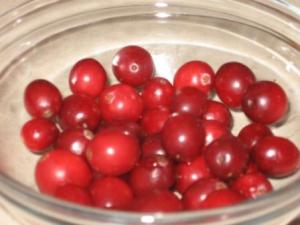
The fall brings a harvest of colorful and delicious fruits and vegetables, and among them is the favorite fruit of the season: the cranberry. Imagine that lusty turkey dinner without a spoonful or slice of cranberry sauce on the side, or a splash of its juice in a punch or cocktail. One can’t think of the fall and holiday eats without thinking about the cranberry!
The cranberry is one of three fruits native to North America. They grow wild in sandy bogs and marshes mainly in the Midwest and Northeast. Native American used the berry for food, medicine and to dye fabric. The Pilgrim s are believed to have eaten cranberries at the first Thanksgiving, and gave them their name: They were called “crane berries” because the blossom of the plant resembled the head and bill of a crane.
Cranberries were first cultivated commercially around 1816. Berries were picked by hand until the 1850s, when a scoop was invented with fingers to gently pull the fruit from the vines and collect in bins. Mechanical harvesters were introduced in 1947, and wet harvesting was first successfully used in the 1960s. In wet harvesting, bogs are flooded with water, then the waters are agitated to shake the berries from their vines. The berries contain pockets of air that causes them to float to the top of the water – just like you see in this video – where they are easily gathered and lifted from the water surface.
Cranberries were eaten by sailors to prevent scurvy. It makes good sense, given the health benefits of the berry. But eating them as is… yuck! which is why cranberries are most often cooked with some kind of sweetener. What we call cranberry juice (the contains sweeteners and sometimes other fruit juices to soften that bitter taste (because it’s not 100% juice, the industry, by law, must call them “juice cocktails”). Unsweetened, the berries add a nice tartness to desserts and savory dishes.
Of the many ways to cook with cranberries, the best known application is the aforementioned cranberry sauce. If you’re feeling culinarily adventurous this season, consider skipping the can shaped stuff and making your own! It’s as easy as simmering the berries in sugar and water. The berries pop and release pectin, which thickens the sauce. You can add other autumn fruits for added flavor and texture. Check out my preferred cranberry sauce recipe: You’ll never use canned again!
Learn more about cranberries from:
The Cape Cod Cranberry Growers’ Association
The Wisconsin State Cranberry Growers Association
If you’re curious about the fate of the berries pictured above, visit our Flickr page to see them used in a Banana-Walnut Christmas Bread, found in Santa’s North Pole Cookbook.





You must be logged in to post a comment.